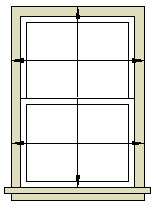Where do I measure for my interior shutters and exterior shutters?

Typically both interior and exterior shutters are mounted within the Window opening. This is
referred to as an inside mount. For inside mounted shutters you would measure between the side
window jambs/casings for the width and from the inside edge of the top jamb/casing to the sill/floor
for the height.
When there is not enough depth for the shutters or you wish the shutters to cover over the entire opening,
trim work and all, you would use an outside mount. For outside mounted shutters you would
measure the distance between the outer edges of the side trim for the width and from the top of
the top trim to the sill/floor for the height.
Outside mounted shutters will require a separate piece of wood from which to hang the shutters.
This must be properly mounted into a wall stud to ensure that it will hold the weight of the shutters.
|

Inside Mount |

Outside Mount |
How do I know if my window is deep enough for an inside mount ?
Use the following guide to determine the window depth you need.
- Raised / Flat / Recessed panel shutters - 1.3/8" depth
- Tongue & Groove, Beadboard, Glass/Mirror or Fabric
- Board and Batten for inside mount - 2.1/8" / for outside mount - 7/8"
- Fixed louver shutters - 1.3/8" depth.
- 1.7/8" Traditional operable louver shutters - 1.3/4" depth.
- 2.1/2" Plantation operable louver shutters - 2" depth
- 3.1/2" California/Contemporary operable louver shutters - 2.7/8" depth
If your window does not have this depth you will most likely need to go with an outside mount installation.
Please note that the above depth allowances take into consideration that the standard thickness of all Kestrel
shutters is 1.1/4". Thicker shutters measuring 1.3/4" and thinner shutters measuring 13/16" thick
are also available. Thinner shutters are typically used for cabinet doors and for older homes where the shutters
sat within wall pockets.
|
What if my windows are not square ?
It is always a good idea to
measure each opening in more than one place so as to make sure that the
opening is square. If the opening is not square you have a few options:
- Order shutters to fit the largest size of the opening and then trim down the edges to match the
window.
- Mount strips of wood to the inside of the window frame. These strips should be tapered to compensate
for the window frame being out of square. The shutters can then be mounted to these strips.
- Order shutters for the smaller size to avoid any trimming. This will result in some light seeping in
through the gaps where the opening is larger. Small wooden strips can be tacked to the inside of your
opening, just behind the shutters, to prevent this. Having an overlap rabbet where the
shutters meet will also keep light out.
|
How many shutters should there be in each opening?
As all windows are a different size we do not make stock shutters. Every shutter is made for
a specific opening for each individual order. This means our shutters are custom sized and this
allows you to have any number of individual shutters within an opening that you would like.
Here are a few things to consider when determining how many shutters to place within an opening:
- Does the window open? If not, you will most likely not have reason to open the shutter frame often
except to wash the window glass. This would be a reason to go with as few shutters as possible.
This will maximize visibility and minimize costs.
- If the window opens, and you plan to open it fairly often, how much clearance do you have between the
window and furniture? This will help to determine the maximum size of the individual shutters. From this
you can figure how many shutter to order for the opening.
- The narrower the shutter the less visibility you will have. Keep in mind that where two shutters meet
you will have two stiles (vertical frame members) blocking out any light and airflow.
- Just because the other windows in the room have two shutters each does not mean that every window has
to have two shutters. Try maintaining the same size shutter throughout the room.
- If the best size for your opening means having an odd number of shutters this does not need to be a
problem. If you have only a single opening in a particular wall the number of shutter will not look
strange as there is nothing else to compare it to. If there is more than one opening in the wall try
being symmetrical with the shutters in regards to how you hinge each one.
- If you can not make up your mind what looks best try cutting pieces of paper or cardboard to
represent each shutter within the opening. By placing these cutouts within the opening you will
get a better feel for the final picture.
|










